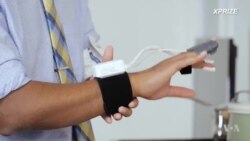Star Trek, the iconic science fiction television and film series, feature a medical device called a "tricorder." In the show, a doctor can use this handheld device to check a person's vital signs and diagnose illness. What was once imagined is now a reality.
The Qualcomm Tricorder XPRIZE challenged scientists to develop a tricorder-like mobile device to improve health care globally. Out of 300 entries from countries around the world, a team called “Final Frontier Medical Devices” won first place and $2.6 million.
“I’m still in shock, still don't believe it,” said emergency room doctor Basil Harris, leader of the winning team. “It's really been a wild family reunion every weekend, nights and weekends of putting this together over the last five years.”
Friends and family approach
Harris and his team of family members range in expertise from computer science and medicine, to engineering and health policy. Harris, his siblings and some friends developed the device they named DxtER.
“When I got involved in the competition, it's a crazy idea build a 'tricorder' so who's going to listen to you but your own family?” said Harris.
DxtER includes a collection of non-invasive sensors that collect data about a person's vital signs, body chemistry and biological functions, and is able to diagnose numerous illnesses such as anemia, diabetes and pneumonia as a part of the competition's criteria.
Taiwan group places 2nd
Taiwan-based Dynamical Biomarkers Group won 2nd place for developing a mobile diagnostic device for consumers. With members from Taiwan, China and the U.S., and in partnership with HTC, the team received $1 million for developing a device called DeepQ.
Inspired by the traditional Chinese medicine's method of “observe, listen, inquire and feel,” this device includes the ability to monitor a person's vital signs, has a blood urine test kit, and two camera lenses to allow the device to “see,” along with a smart phone and application.
“There's a mission we want to achieve. That mission is to bring quality health care to everyone, to people maybe in China in rural villages," said Dynamical Biomarkers Group team leader and Harvard Medical School Associate Professor Chung-Kang Peng. "They don't have the resource, so we need money to further develop our system to make it better. We plan to make the system at least five times better than this one.”
Hospital respects the need
Dynamical Biomarkers Group would like to work with the Chinese government to bring DeepQ to selected villages in one to two years.
The General Hospital of Maputo in Mozambique, Africa, has committed to having this type of device for its doctors, nurses and patients.
“I think the fundamental problem that exists that we wanted to address is that there are hundreds of millions of people around the world who have no access to modern health care, and these people exist in remote places of the world," said Grant Campany, executive director of Health and Wellness at XPRIZE. "They exist right here in the United States in the rural areas."
Answer to doctor shortage
With a lack of doctors, nurses and infrastructure in many parts of the world, Campany said technology provides one solution to the shortage.
“This is the type of device that can help level the playing field across the board," said Harris. "From remote villages to urban centers to refugee camps, this stuff can be deployed and really, really make a difference."
Campany said developing a real working medical device out of science fiction is possible because it is a unique time in technological history.
“Technologies that existed that were extremely expensive just five or 10 years ago are now being produced at scale that makes them so inexpensive, and it's that fact that provides a lot of these technologies to be accessible to more people and easier to actually incorporate into new devices," said Campany.
Partnering with FDA
In the U.S., the devices need to go through a rigorous approval process with the U.S. Food and Drug Administration.
“We're talking about devices that are so complex they've never been designed before, and so we're entering new territory here, and that's why we've partnered with the FDA so that we can work together, so that we can understand what it is the FDA's going to be looking at as far as providing the teams with guidance,” Campany said.
It is a process Harris said could take five to seven years, before consumers on a wide scale can purchase a tricorder-like device for around $200.











